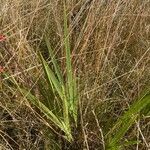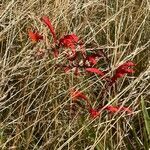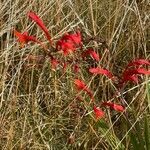Robust and leafy, to c. 1.5 m high. Corm ± 5 × 4 cm, subglobose, tunic papery, smooth, light brown. Leaves broadly ensiform, < stem to 5 cm wide, plicate, tightly sheathing at base, spreading into a fan about half-way up stem. Stem c. 5 mm diam., terete, sturdy. Inflorescence with several stout branches above, some again branched, main axis and each branch terminating in a strongly zigzag portion with alternate sessile flowers; spathe-valves light brown, red-tinged, ± 6 mm long. Flowers orange, crimson-tinged, 3.5-4 cm long ± 1.5 cm diam.; tube ± 1 cm long, narrow, slightly widening above; lobes spreading, uppermost lobe longer and hooded, others ± equal, outer more acute. Capsule ± 3 mm long, brownish, oblong-trigonous. Seeds reddish, compressed-triangular.
Perennial herb, geophyte, 1.2-1.5 m high; corm globose, in superposed rows, tunics brown, papery; stem usually dull purplish red, cylindrical, branched. Leaves lanceolate, plicate, acuminate, 400-900 x 15-80 mm; veins prominent. Bracts submembranous, reddish brown, exceeding length of internode. Inflorescence a spicate panicle, arching outwards or horizontal, branches strongly zigzag in upper part; flowers deep orange to orange-brown, (sub)secund, zygomorphic, distichous at first, becoming ± secund on apex of branches; tube cylindrical below, funnel-shaped above; lobes unequal. Stamens curved towards posticous lobe; filaments up to 40 mm long; anthers unilateral, contiguous. Flowering time Dec.-Feb. Capsule globose, 3-lobed.
Flowers orange to red or red-brown, zygomorphic, facing to the side; perianth tube curved, (25)30–40(45) mm long, tubular in the lower half, infundibuliform above; tepals unequal, obtuse, the uppermost longest, (10)15–18 × 6–9 mm, the upper laterals 7–10 mm long, spreading, the lower 3 tepals 6–12 mm long, the median one smallest.
Geophyte, up to 1.8 m high, plants in large clumps. Leaves with blade plicate, 400-600 x 25-50 mm. Flowers: branches of panicle strongly zigzagging in upper part; perianth narrowly funnel-shaped, up to 75 mm long, tube at least twice length of segments, orange-red, rusty red or brownish orange; Jan., Feb.
Geophyte, up to 1.8 m high. Perianth tube at least twice the length of the segments. Leaves plicate, 400-600 x 25-50 mm. Branches of panicle strongly zigzag in upper part. Flowers narrowly funnel-shaped, up to 75 mm long. Plants in large clumps. Flowers orange-red, rusty red or brownish orange.
Foliage leaves several, basal and cauline, half to two-thirds as long as the stems, lanceolate, plicate, narrowed and thickened below into a pseudopetiolate base; cauline leaves shorter than the basal.
Spikes rather congested, 10–22-flowered, flexuous; bracts firm, green, becoming reddish-brown, 7–10 mm long, exceeding the internodes, the outer obtuse or apiculate, the inner shortly 2-toothed.
Stem inclined above, relatively thick, up to 9 mm in diameter, 2–5-branched, the branches nearly horizontal.
Corms single or in chains of 2–3, 2.5–4(5) cm in diameter; tunics brown, membranous, later fibrous above.
Stamens unilateral, arched under the uppermost tepal; filaments 25–40 mm long; anthers 6–8 mm long.
Capsules 12–14 mm long, globose; seeds 4 mm in diameter, globose or angled.
Style dividing near the anther apices, the branches 4–6 mm long.
Plants 100–130 (180) cm high.



